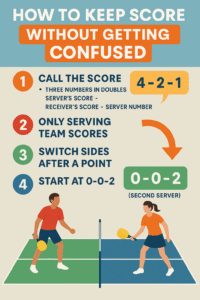If you’ve ever played pickleball and found yourself nodding along while your opponent confidently calls out “4-2-1” — even though you’re not entirely sure what that means — you’re not alone.
Pickleball scoring can feel a little tricky at first. Unlike tennis or badminton, pickleball uses a three-number scoring system and has its own unique rules for serving and winning points.
But here’s the good news: once you understand the logic behind it, keeping score becomes second nature. By the end of this guide, you’ll not only know how to keep score without getting confused — you’ll also be able to explain it to beginners, call the score confidently, and avoid common mistakes.
Why Pickleball Scoring Feels Confusing at First
Pickleball is a hybrid sport, borrowing elements from tennis, ping pong, and badminton. The rules are simple, but the scoring trips people up for three main reasons:
-
Three numbers instead of two
The score is called as server’s score – receiver’s score – server number. That third number (server number) is what throws most new players. -
Only the serving team can score points
Unlike some sports, if you’re on the receiving team, you can’t earn a point by winning a rally — you just earn the right to serve. -
Double serve rotation
Each team gets two serving turns per rotation — one for each player — except at the very start of the game.
Once you understand these, the rest is just repetition.
The Basics of Pickleball Scoring
1. Games Are Played to 11 Points (Usually)
-
In recreational play, games are typically to 11 points, win by 2.
-
In tournament play, games may go to 15 or 21 points, still win by 2.
2. Rally Scoring vs. Side-Out Scoring
-
Pickleball uses side-out scoring, meaning you can only score when you are serving.
-
If the receiving team wins the rally, they don’t get a point — they just get the serve.
3. The Three-Number Format
Scores are always called in the format:
Server’s score – Receiver’s score – Server number
Example:
“4-2-1” means:
-
The serving team has 4 points
-
The receiving team has 2 points
-
The first server of the team is serving
How Serving Works
To understand scoring, you need to understand the serving sequence:
-
Start of the Game
The game starts with only one server on the first serving team. This is why you’ll hear “0-0-2” at the very beginning — the “2” means it’s the second server’s turn, but in this case, it’s just the start rule. -
Two Serves Per Team
After the initial serve, when your team gets the serve back, both players get to serve before the serve goes to the other team. Player 1 serves until they lose a rally, then Player 2 serves. When Player 2 loses a rally, the serve goes to the opponents. -
Switching Sides After a Point
Every time the serving team wins a point, the servers switch positions.
Step-by-Step Example of Scoring in Action
Let’s walk through an example doubles game to make it crystal clear:
Start of Game
-
Score: 0-0-2 (Second server start rule)
-
Server A serves from right-hand court
-
They win the rally → 1-0-2
-
Switch sides, Server A serves from the left-hand court
-
Lose rally → side-out to opponents
Opponents Serve
-
Score: 0-1-1 (Opponent’s first server)
-
Opponent wins rally → 0-2-1
-
Lose rally → 0-2-2 (Second server serves)
-
Lose rally → side-out back to you
And so on.
Singles Scoring
In singles, there’s no server number because you’re always the server or the receiver. You simply call server’s score – receiver’s score.
Also, in singles, you serve from the right-hand side if your score is even, and from the left-hand side if it’s odd.
Calling the Score Correctly
Why Calling the Score Matters
-
It avoids confusion about whose turn it is.
-
It ensures everyone knows the official score before the rally starts.
-
In tournaments, failing to call the score clearly can even result in a fault.
Tips for Clear Score Calling
-
Speak loudly and clearly before serving.
-
Use a consistent rhythm: server score → receiver score → server number.
-
For example: “Five – three – one!”
Common Mistakes and How to Avoid Them
-
Forgetting the Server Number
-
Tip: Always remember who started serving when your team got the ball.
-
-
Awarding Points to the Receiving Team
-
Remember: Only the serving team scores.
-
-
Forgetting to Switch Sides
-
If you win a point on your serve, you must switch sides with your partner before serving again.
-
-
Starting in the Wrong Position
-
Use the “even–right, odd–left” rule to figure out where you should be.
-
Tricks to Keep Score Without Getting Confused
1. The Wristband Method
If you’re prone to forgetting the server number, wear a wristband or tie a bandana on the first server so everyone remembers who started.
2. The “Who Served First” Rule
Always track which player served first on your team — it determines where you should be standing for the rest of the game.
3. Call the Score Every Time
Don’t skip it — calling the score every rally keeps everyone on track.
4. Mental Anchors
Associate certain scores with positions.
Example: “When I have 4 points, I’m always on the left side when serving.”
How Scoring Works in Tournaments
In official tournaments:
-
The referee calls the score, not the players.
-
Players must serve after the score is called.
-
Delay or incorrect serves after score calling can result in a fault.
Scoring Variations You Might Encounter
While standard side-out scoring is the norm, you may encounter:
-
Rally scoring (both sides can score on any rally)
-
Modified scoring for casual or timed games
Practice Drills to Master Scoring
-
Shadow Scoring
Stand on court with a partner and “play” imaginary rallies, calling out the score after each. -
Reverse Role
Have one player act as referee, calling the score for both sides, then switch. -
Mini Games
Play to 5 points only, focusing entirely on correct score calling.
Final Thoughts
At first, pickleball scoring might feel like juggling numbers in your head. But with repetition and a few memory tricks, it will become second nature.
The key points to remember:
-
Always call server score → receiver score → server number
-
Only the serving team scores
-
Switch sides after each point scored on your serve
Once you have the hang of it, you’ll spend less time scratching your head over “What’s the score again?” and more time enjoying the game.
Quick Reference: Scoring Cheat Sheet
-
Games to 11, win by 2 (standard)
-
Only serving team scores
-
Call three numbers in doubles
-
Start game at 0-0-2
-
First server of the game only serves once before side-out





